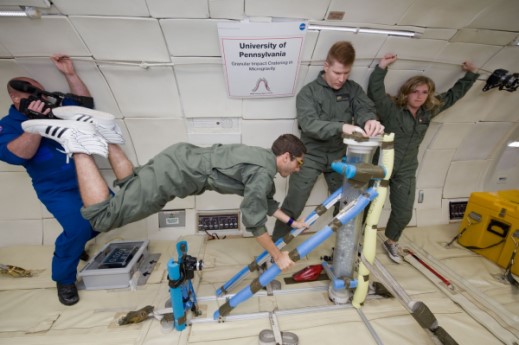Alumni Making Out of this World Experiences a Reality

Alumnus Guy Chriqui became interested in helping advance space exploration while leading a project for the NASA Micro Gravity University program on the reduced-gravity Vomit Comet aircraft as a Rose-Hulman student.
Advancements in computer technology are leading the improvements in rocket engine design that are launching a new frontier in space exploration. That’s the insight of alumnus Ron Neumeyer, who has seen the ups and downs of the space industry during more than 30 years as a research engineer with Aerojet Rocketdyne.
The California-based company provides propulsion systems and energetics to domestic and international customers in the space, missile defense and strategic systems, and tactical systems areas. Aerojet Rocketdyne has had successful hot-fire tests of RS-25 engines that were remnants from the Space Shuttle program that will be used on NASA’s Space Launch System for the first crewed mission to the moon and eventually Mars.
“There have been so many rocket tests and Shuttle launches, more than 3,100 since we started testing in 1975 that we often dig back through old data to evaluate performance under some unique conditions that happen to occur on an old test,” says Neumeyer.
The 1986 mechanical engineering graduate honed his engineering skills by analyzing test data of engines developed for the shuttle program and helped perfect liquid rocket engine programs used on Delta IV rockets to launch satellites.
“Much of the improvements in today’s rocket engine design are because of faster computers, which aid detailed analysis and simulations. 3-D manufacturing is being implemented to reduce the time it takes to build engines. We are dependent on the vast engine test history that is available,” states Neumeyer.
Today, he is working on the RS-25 engine, with new controller electronics and manufacturing techniques, for NASA’s Space Launch System program. These tests will confirm if these new techniques perform at the higher thrust levels required for a successful launch.
In Other Work . . .
Guy Chriqui, a 2011 mechanical engineering alumnus, is a senior research engineer at Lockheed Martin’s Advanced Technology Center, where his work focuses on opto-mechanical systems design and development. He leads the development of a photonic integrated circuit-based imaging system that could significantly shrink the telescope (by factors of 10 to 100 times) through interferometric imaging approaches.
Before joining Lockheed Martin, Guy’s career path included assignments at Boeing, NASA and Moon Express, leading teams that developed Lunar Micro Rovers in an effort to make a commercial-off-the-shelf rover a reality.
Outside of work, Guy is an active mentor for students in robotics and he was a robotics advisor for Disney’s Academy Award-winning film, Big Hero 6. In addition, the Science Channel has recognized him as a Science Super Hero for his work in STEM outreach.
During his studies at Rose-Hulman, Guy led a project for the NASA Micro Gravity University program, with his experiment on micro-gravity cratering in regolith being flown on the space agency’s reduced-gravity aircraft, better known as the Vomit Comet. He later earned a master’s degree in astronautical engineering at the University of Southern California.
Another Vomit Comet veteran is Kris Verdeyen, who is a principal electrical engineer at Texas’ Houston Mechatronics, which is developing an Aquanaut remotely operated/autonomous underwater vehicle to assist with oil and natural gas exploration without the expense or hassle of a tether. Just prior, as a robotics engineer at NASA’s Johnson Space Center, the 2000 electrical engineering graduate managed the development of NASA’s Valkyrie full-scale humanoid robot to explore the potential of bipedal walking on Mars and other planetary services. That development could lead to colonization in space.
NASA’s earlier humanoids featured Robonaut and the far more advanced Robonaut 2, with an upper-body confirmation mounted on several different lower bodies. Robonaut 2 made its way to the International Space Station in 2011. Now, astromech droids that are similar to the R2-D2 in the “Star Wars” movies are being developed to help repair spaceships wherever they might be throughout the universe.
Verdeyen says, “Everybody thinks robots, like we see in the movies, are far off, and they are, but they’re less far off than they were five or 10 years ago.”
He also led the development of solar, battery and power distribution systems for a mission to land a rover near one of the moon’s poles and test permanently shadowed regions for water and hydrogen. At Rose-Hulman, he was a member of the first student group to have a project on the Vomit Comet aircraft.